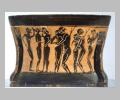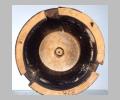| Collection: | University Museums, University of Mississippi |
| Summary: | Side A: Bride(?) and men conversing. Side B: Men and women conversing. Side C: Courtship of men and boys. |
| Ware: | Attic Black Figure |
| Context: | Said to be from Athens |
| Date: | ca. 550 BC |
| Dimensions: | H. 0.055 m., D. 0.085 m. |
| Primary Citation: | |
| Shape: | Tripod pyxis |
| Beazley Number: | 7285 |
| Region: | Attica |
| Period: | Archaic |
Decoration Description:
Side A: In the center of the composition a woman wearing a peplos stands facing left. She has been interpreted as a bride because she holds a veil over her face. Two male figures stand on each side of her. The figure at the far left is naked except for a chlamys. The other three men wear long garments. Side B: In the center of the scene, two women wearing peploi stand facing one another, sharing a veil or cloak. A naked youth with a chlamys over one arm stands at the left. On the right two men in long garments converse. Side C: Three couples occupy the center of the composition. The couple on the left are courting. The man uses the standard courting gesture, reaching for the youth's chin with one hand and his genitals with the other. The other two couples are engaged in intercrural sex. On the left of the scene a naked youth dances. At the right a bearded man holds a cock, a standard courting gift.
Homosexual courting scenes have a limited production period in Athens from circa 560 to 475 with a floruit from circa 550 to 500.
Shape Description:
The pyxis was a container for jewelery or cosmetics. the tripod pyxis has three broad legs, which are also the main area of the vase for decoration. The tripod pyxis was never a common shape in Attic black-figure, but reached the height of its popularity in the mid sixth century.
Essay:
Collection History:
Once in the Robinson collection. Harvard Inv. no. 155.
Sources Used:





